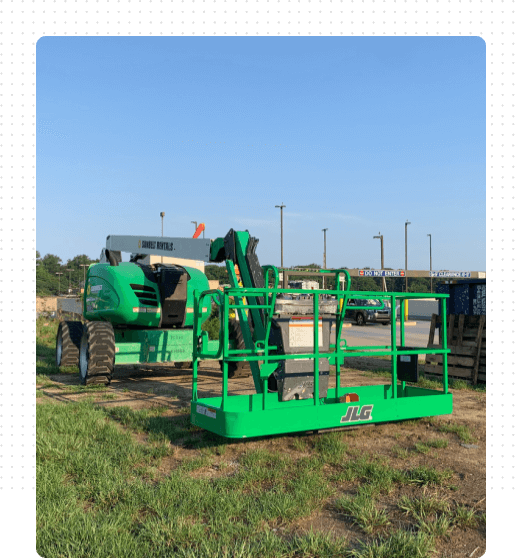Be Advised :
Boom Lift/Scissor Lift (MEWP) training must consist of both a classroom and hands-on portion to comply with the new ANSI A92 standards; online trainings are not compliant.
Operators must be properly trained to safely use equipment to minimize the risk of injuries, property damage, and worksite liability.
The new ANSI A92 standards were developed to promote efficiency and safe use of Mobile Elevating Work Platforms, formally known as aerial work platforms .
Anyone qualified under the current standards will not be qualified under the new ANSI A92 standards until they undergo additional training. The deadline to meet ANSI A92 standards was June 1, 2020.
Boom Lift/Scissor Lift (MEWP) training must consist of both a classroom and hands-on portion to comply with the new ANSI A92 standards; online trainings are not compliant.

per person
We specialize in private classes. Inquire about setting up a private class for your team and ask about group discounts.



English, Spanish

Onsite Training

Enter your details and connect with us today!

One of our experts will reach out to you within 24 hours!




Scissor lifts and boom lifts are integral pieces of machinery in the construction and maintenance sectors. Powered by intricate hydraulic systems, these machines have distinct mechanisms that allow them to serve their unique purposes on job sites nationwide.
A scissor lift operates by using a series of linked, folding supports in a criss-cross ‘X’ pattern, known as a pantograph. The upward motion is achieved by applying pressure to the outside of the lowest set of supports, elongating the crossing pattern and propelling the work platform vertically.
On the other hand, boom lifts, often referred to as cherry pickers, utilize a hydraulic arm that can extend both vertically and horizontally. This arm provides the flexibility to reach areas that are not directly above the machine, making it especially valuable for tasks that require a greater range of motion.
Given the complexities and capabilities of these machines, it’s evident why they play such a pivotal role in various industries. They allow workers to access high or hard-to-reach areas safely, perform tasks efficiently, and ensure that projects are completed to the highest standards. However, with their power and range of motion comes a responsibility to operate them safely.
To ensure the safety of operators and those around them, it’s crucial to undergo specialized scissor lift and boom lift training. OSHA-approved operator certification and safety training are not just legal requirements but are essential for understanding the nuances of these machines. Proper training ensures that operators are well-equipped to handle any situation, reducing the risk of workplace accidents. Fast Line Safety Training recognizes the importance of this and offers comprehensive scissor lift and boom lift training, ensuring that every operator is confident, competent, and compliant with safety standards.
In the dynamic and often high-risk environment of the construction industry, ensuring safety and operational efficiency is of utmost importance. Acquiring scissor lift certification and boom lift certification goes beyond mere regulatory compliance; it’s a proactive step towards establishing a culture of safety and professionalism.
For individuals working in the field, these certifications provide a solid foundation of knowledge, ensuring they are well-equipped to handle the intricacies of these machines. Accidents involving scissor and boom lifts can lead to severe injuries or even fatalities. Being certified reduces these risks significantly, as operators are trained to anticipate and mitigate potential hazards, ensuring not only their safety but also the safety of their colleagues on the job site.
From an operational standpoint, certified operators tend to be more efficient. They understand the machines’ capabilities and limitations, ensuring tasks are executed correctly, reducing the chances of costly mistakes or rework. This proficiency also means less wear and tear on the equipment, leading to decreased maintenance costs and extended equipment lifespan.
For those overseeing projects or managing teams, having certified operators signals a commitment to best practices. It can enhance the reputation of a company or a contractor, making them more appealing to clients who prioritize safety and professionalism. Moreover, in the competitive landscape of construction bids and contracts, having a team of certified operators can provide a competitive edge, showcasing a commitment to excellence and industry standards.
In an industry where every decision can have significant ramifications, the decision to get certified is a clear investment in safety, efficiency, and professional growth.
If you’ve been in the industry for a while, you might be more familiar with the term AWP (Aerial Work Platforms). However, with the introduction of the new ANSI A92 standards, there’s been a shift in terminology.
These machines are now formally referred to as MEWPs. This change reflects a broader understanding and categorization of these machines, ensuring clarity and consistency in safety protocols and training procedures.
The ANSI A92 standards are not just a set of arbitrary rules. They provide comprehensive criteria for various aerial work platforms. This includes vehicle-mounted rotating and elevating work platforms, elevating aerial platforms, and boom-supported elevated aerial platforms. By adhering to these standards, companies ensure the safety of their workers and the efficiency of their operations. Anyone seeking scissor lift certification or boom lift certification should be well-versed in these standards.
With the introduction of the updated ANSI A92 standards, there’s a clear mandate: scissor lift training and boom lift training must be conducted in person. This isn’t a mere procedural change. The emphasis is on gaining practical, hands-on experience. While understanding the theoretical aspects of operating these machines is essential, the real test lies in physically managing the controls and adeptly navigating potential risks.
Moreover, the standards dictate that it’s not just the primary operator who needs this training. Every individual who might occupy the machine must be proficient in operating the MEWP (Mobile Elevating Work Platforms) controls. This comprehensive approach ensures that in unforeseen circumstances, like emergencies or if the main operator is unable to function, any occupant can take control safely.
Online training platforms fall short in meeting these rigorous standards, leaving them non-compliant. This is where Fast Line Safety Training stands out. We prioritize on-site, in-person training, ensuring every participant is thoroughly equipped. For added convenience, we can even come to your location, ensuring you receive the best training and certification, right where you are!
At Fast Line Safety Training, we’re not just about imparting top-tier training; we’re about equipping our students with cutting-edge tools for real-world verification. Once students successfully complete our course, they are immediately issued on-site temporary cards. But our standout feature is the permanent ID cards embedded with NFC technology that students receive upon course completion.
These ID cards, valid for three years and recognized across all 50 states, are a testament to our commitment to innovation and convenience. With a simple tap or proximity of a smartphone to the NFC chip on the card, training verification is instantaneous, eliminating the need for cumbersome paperwork or manual checks. We take pride in being the only providers issuing such advanced cards, offering a glimpse into the future of certification verification.
Understanding the diverse needs of businesses, whether large or small, is at the core of our principles. Our goal is to streamline the certification process, making it adaptable and straightforward. By choosing Fast Line Safety Training, you’re ensuring your team receives unparalleled training without logistical complications. Step into the future of safety training with us.
Our training offers more than just compliance with OSHA standards. Here’s what our program covers:
Safe operation of scissor lifts under various conditions.
Identification and use of lift controls.
Navigating around obstacles and pedestrians.
Handling scissor lifts on different terrains.
Loading, moving, and unloading cargo.
Routine maintenance and inspections.
Hazard assessment in the surrounding environment.
Untrained or improperly trained workers can lead to accidents, resulting in property damage, equipment damage, or even severe injuries. It’s illegal for employers to let workers operate scissor lifts without proper certification. With our training, you can avoid expensive fines, penalties, and potential litigation.
Fast Line Safety Training is proud to offer this certification across New York, New Jersey and Pennsylvania. Explore the links below to discover more about this certification in other areas:
We aim to equip our clients and their workers with the tools and knowledge to get home safely every day through comprehensive training solutions.
Outline

